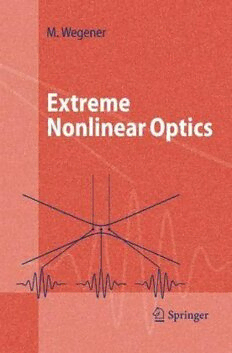Table Of ContentExtremeNonlinearOptics
AdvancedTextsinPhysics
This program of advanced texts covers a broad spectrum of topics which are of
currentandemerginginterestinphysics.Eachbookprovidesacomprehensiveand
yetaccessibleintroductiontoafieldattheforefrontofmodernresearch.Assuch,
thesetextsareintendedforseniorundergraduateandgraduatestudentsattheMS
andPhDlevel;however,researchscientistsseekinganintroductiontoparticular
areasofphysicswillalsobenefitfromthetitlesinthiscollection.
Martin Wegener
Extreme
Nonlinear Optics
An Introduction
With86Figures,NumerousExamples,
and29ProblemswithCompleteSolutions
123
ProfessorDr.MartinWegener
InstitutfürAngewandtePhysik
Universita¨tKarlsruhe(TH)
Wolfgang-Gaede-Str.1
76131Karlsruhe,Germany
E-mail:[email protected]
ISSN1439-2674
ISBN3-540-22291-x Springer-VerlagBerlinHeidelbergNewYork
LibraryofCongressControlNumber:2004109596
Thisworkissubjecttocopyright.Allrightsarereserved,whetherthewholeorpartofthematerial
isconcerned,specificallytherightsoftranslation,reprinting,reuseofillustrations,recitation,broad-
casting,reproductiononmicrofilmorinanyotherway,andstorageindatabanks.Duplicationof
thispublicationorpartsthereofispermittedonlyundertheprovisionsoftheGermanCopyrightLaw
ofSeptember9,1965,initscurrentversion,andpermissionforusemustalwaysbeobtainedfrom
Springer.ViolationsareliabletoprosecutionundertheGermanCopyrightLaw.
SpringerisapartofSpringerScience+BusinessMedia
springeronline.com
©Springer-VerlagBerlinHeidelberg2005
PrintedinGermany
Theuseofgeneraldescriptivenames,registerednames,trademarks,etc.inthispublicationdoesnot
imply,evenintheabsenceofaspecificstatement,thatsuchnamesareexemptfromtherelevantpro-
tectivelawsandregulationsandthereforefreeforgeneraluse.
Typesetting:bytheauthorandF.HerwegEDVBeratungusingaSpringerTEXmacropackage
Coverdesign:design&productionGmbH,Heidelberg
Printedonacid-freepaper SPIN10984680 56/3141/jl 5 4 3 2 1 0
ThisbookisdedicatedtoKarin,Pauline,andHenriette.
Preface
In2001Iwasinvitedtogiveaseriesoflecturesonourworkonstrong-fieldexcitation
ofsemiconductorsata2003summerschoolinErice(Sicily).Ienthusiasticallystarted
preparingthelecturesandsoondevelopedtheideatoputourownworkintoamuch
broadercontext.Whenreadingtheoriginalpublicationsfromdiversefieldssuchas
solid-statephysics,atomicphysics,relativisticphysics,particlephysicsandmetrol-
ogy,Iwasatfirstoverwhelmedbytheamountofmaterialanditsdiversity.Awhole
newworldofnonlinearopticsopeneduptome.Then,Irealizedmanysimilaritiesin
thephysics,despitetremendousdifferencesinthejargonofthevariousscientificcom-
munities.ManyoftheseexcitingandnovelexamplesofExtremeNonlinearOptics
hadnotbeendescribedinanytextbook–soIdecidedtowritethisbook.
Itgivesanintroductionintothisvibrantfieldfromtheviewpointofanexperimen-
talphysicistwhocaresabouttheory.Chaptersonetosixdeliverthebasics.Whenever
necessary,crucialresultsfromtraditionalnonlinearopticsarebrieflyrecapitulated.
More than twenty problems with detailed solutions at the end of the book, as well
asmanyexamples,areanintegralpartofthisintroduction.Chapterssevenandeight
reviewthefieldandguidethereadertowardsitscurrentstate-of-the-art.
Thus,thisbookshouldbehelpfulforstudentsofphysicsorelectricalengineering
in courses/seminars on nonlinear optics, quantum optics or quantum electronics as
wellasforyoungresearchersenteringthefieldofextremenonlinearoptics.Expertsin
oneofthesubfieldsmightbesurprisedbytheinterconnectionsandparallelsbetween
thedisciplines.
Karlsruhe,June2004 MartinWegener
Contents
1 Introduction................................................. 1
1.1 “Traditional”NonlinearOptics–ExtremeNonlinearOptics....... 1
1.2 HowtoReadthisBook?..................................... 6
2 SelectedAspectsofFew-CycleLaserPulsesandNonlinearOptics ... 9
2.1 MaxwellEquations ......................................... 9
2.2 TheLightIntensity ......................................... 10
2.3 ElectricFieldinaLaserResonator ............................ 11
2.4 ABriefLookatPhenomenologicalNonlinearOptics............. 19
2.5 Even-HarmonicGenerationandInversionSymmetry............. 21
2.6 PrincipleofMeasuringtheCarrier-EnvelopeFrequency .......... 23
3 TheLorentzOscillatorModelandBeyond... ..................... 27
3.1 LinearOptics:RevisitingtheLorentzOscillatorModel ........... 27
3.2 Two-LevelSystemsandRabiEnergy .......................... 29
3.3 Carrier-WaveRabiFlopping ................................. 33
3.4 FrequencyDoublingwithInversionSymmetry .................. 38
3.5 QuantumInterferenceofMultiphotonAbsorption ............... 41
3.6 HighHarmonicsfromTwo-LevelSystems...................... 46
3.6.1 The“Static-FieldApproximation” ...................... 51
3.6.2 The“Square-WaveApproximation”..................... 53
3.6.3 TheDressedTwo-LevelSystem:FloquetStates........... 57
4 TheDrudeFree-ElectronModelandBeyond... ................... 61
4.1 LinearOptics:TheDrudeModel.............................. 61
4.2 ElectronWavePacketsDrivenbyLight ........................ 63
4.2.1 SemiclassicalConsiderations .......................... 63
4.2.2 Quantum-MechanicalTreatment:DressedElectrons ....... 64
4.3 CrystalElectrons........................................... 71
4.3.1 Static-FieldCase..................................... 71
4.3.2 HighHarmonicsfromCarrier-WaveBlochOscillations .... 72
X Contents
4.4 ExtremeNonlinearOpticsofRelativisticElectrons .............. 75
4.4.1 Second-HarmonicGenerationandPhotonDrag........... 78
4.4.2 NonperturbativeRegime .............................. 81
4.5 ExtremeNonlinearOpticsofDiracElectrons ................... 86
4.6 UnruhRadiation ........................................... 91
5 LorentzBecomesDrude:Bound–UnboundTransitions............. 93
5.1 High-HarmonicGeneration:PhenomenologicalApproach ........ 93
5.2 TheKeldyshParameter...................................... 96
5.3 FieldIonizationofAtoms.................................... 99
5.4 High-HarmonicGeneration .................................. 104
5.4.1 Three-StepScenarioandCutoff ........................ 105
5.5 ApplicationtoPhotoemissionfromMetalSurfaces .............. 109
6 AccountingforPropagationEffects ............................. 113
6.1 NumericalSolutionoftheNonlinearMaxwellEquations ......... 113
6.2 SlowlyVaryingEnvelopeApproximation ...................... 116
6.3 GouyPhaseandCarrier-EnvelopePhase ....................... 117
6.4 ReshapingoftheAmplitudeSpectrum ......................... 123
7 ExtremeNonlinearOpticsofSemiconductorsandIsolators......... 129
7.1 Carrier-WaveRabiFlopping ................................. 132
7.1.1 Experiment ......................................... 134
7.1.2 Theory ............................................. 139
7.1.3 DependenceontheCarrier-EnvelopePhase .............. 147
7.1.4 SemiconductorBlochEquations........................ 150
7.2 “THGintheDisguiseofSHG” ............................... 152
7.3 DynamicFranz–KeldyshEffect............................... 161
7.4 PhotonDragorDynamicHallEffect .......................... 166
7.5 ConicalSecond-HarmonicGeneration ......................... 169
8 ExtremeNonlinearOpticsofAtomsandElectrons ................ 173
8.1 High-HarmonicGenerationFromAtoms....................... 173
8.1.1 GasJets ............................................ 174
8.1.2 HollowWaveguides .................................. 177
8.1.3 QuasiPhase-MatchinginModulatedCapillaries .......... 179
8.1.4 DependenceontheCarrier-EnvelopePhase .............. 180
8.2 RelativisticNonlinearThomsonScattering ..................... 183
Solutions........................................................ 187
Symbols ........................................................ 205
References ...................................................... 209
Index........................................................... 219
1
Introduction
Withtheinventionofthelaser[1,2]ingeneral,andwiththerealizationoftheruby
laser by Maiman in 1960 [3] in particular, the field of optics soon entered the new
eraofnonlinearopticsin1961[4].Inthisregime,theopticalpropertiesofmaterials
arenolongerindependentoftheintensityoflight–aswasbelievedforhundredsof
yearsbefore–butratherchangewiththelightintensity,givingrisetoawealthofnew
phenomena,effectsandapplications.Today,nonlinearopticshasenteredoureveryday
life in many ways and has also been the basis for numerous new developments in
spectroscopy and laser technology. Indeed, from the moment of birth of nonlinear
optics,laserphysicsandnonlinearopticshavebeenintimatelyrelatedtoeachother.
1.1 “Traditional”NonlinearOptics–ExtremeNonlinearOptics
Within“traditional”nonlinearoptics,theabsolutechangesoftheopticalproperties
aretinyifonefollowsthemversustimeonatimescaleofacycleoflight.Thissimple
fact is the basis of many concepts and approximations of “traditional” nonlinear
optics – as described in a number of excellent textbooks [5–10]. Over the years,
however, lasers have improved in many ways, especially in terms of the accessible
peakintensitiesandintermsoftheminimumpulsedurationavailable.Thesedays,
about40yearsaftertheinventionofthelaser,theshortestopticalpulsesgeneratedare
aboutoneandahalfcyclesoflightinduration(seeFig.1.1).Thiscomesclosetothe
ultimatelimitofasingleopticalcycle.Byvirtueofmode-locking[11]andspecifically
of self-mode-locking [12] of solid-state lasers, such pulses can even be generated
directly from the laser oscillator. Moreover, thanks to the concept of chirped-pulse
amplification(CPA)[16,17],amplifiedlaserpulseswithfocusedpeakintensitiesin
therangeof1022W/cm2[18]areavailableinsomelaboratories(seeFig.1.2).Inten
yearsfromnow,thisgiganticnumbercouldpossiblybefurtherincreasedbyanother
severalordersofmagnitude.Asaresultofthis,today’slightintensitiescanleadto
substantialoreventoextremechangesonthetimescaleoflight.Wewillseelaterin
thisbookthatthissomewhatvaguestatementcanbespecifiedbysaying:
2 1 Introduction
10ps
n
o
ati 1ps
r
u
d
e
s 100fs
ul
p
al 10fs
ptic 2.4fs 6fs
O
1fs
1960 1970 1980 1990 2000 2010
Year
Fig. 1.1. Development of the minimum available laser pulse duration tFWHM versus year
(schematically).Therubylasercameintooperationin1960(arrow)andonlyfiveyearslater,
10-pspulseswereavailable.Thereafter,thepulsedurationdecayedalmostexponentiallyfor
two decades. Not too much happened in terms of duration after the 1987 world record of
Shanketal.[13]basedonadyelaserandadyeamplifier.However,thesubsequentsolid-state
revolution[14,15]ledtoanenormousprogressintermsofreliability.Theshortestpossible
opticalpulsedurationof2.4fsisindicated(thisisequivalentto1.3cyclesoflightat2.25eV
centerphotonenergy,seeProblem2.2).Inthisfigure,wedonotconsidersub-femtosecond
extremeultravioletpulsesgeneratedviahigh-harmonicgeneration(seeExampleIII).
Whenever an energy associated with the light intensity becomes com-
parable to or even larger than a characteristic energy of the material or
systemunderinvestigation,thelawsof“traditional”nonlinearopticsfail
andsomethingnewisexpectedtohappen.
Wewanttocallthisregime extremenonlinearopticsorcarrier-wavenonlinearop-
tics. The latter is more precise, the notion extreme nonlinear optics is popular as it
soundsmore“sexy”.Dependingontheproblemand/orsystemunderconsideration,
theenergyassociatedtothelightintensity,I,canbeoneofthefiveenergies:
√
• Rabienergy(cid:1)(cid:1) ∝ I
R
• Ponderomotiveenergy√(cid:3)Ekin(cid:4)∝I
• Blochenergy(cid:1)(cid:1)B ∝ I√
• Cyclotronenergy(cid:1)ωc ∝ √I
• Tunnelingenergy(cid:1)(cid:1) ∝ I.
tun
The characteristic energy of the system under investigation can be one of the three
energies:
• Carrierphotonenergy(cid:1)ω (ortransitionenergy(cid:1)(cid:1))
0
• BindingenergyE
b
• Restenergym c2.
0 0

